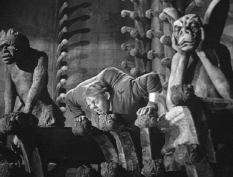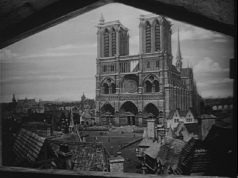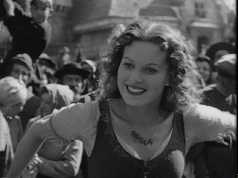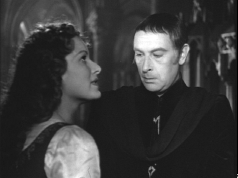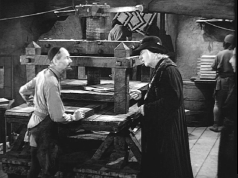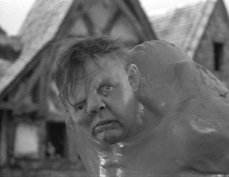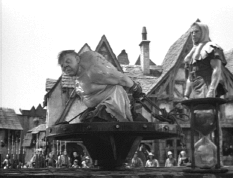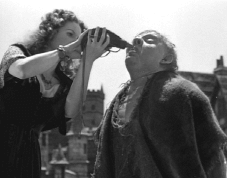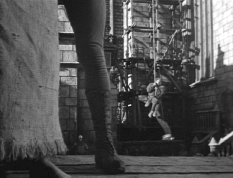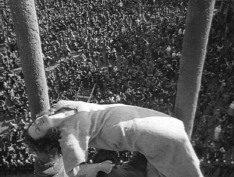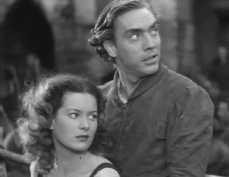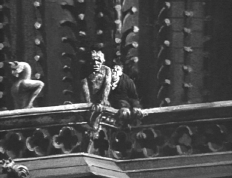The Hunchback of Notre Dame, (1939)
directed by William Dieterle
Review by Gary Tooze
(CLICK ON ALL IMAGES FOR LARGER VERSIONS )
Set in medieval fifteenth century France, "The Hunchback of Notre Dame" is an outstanding adaptation of the Victor Hugo (1802-85) novel of the same name. For its time it had a huge budget with imposing grandiose sets, an all-star cast and magnificent on-location filming. The story revolves are the magnificent Notre Dame Cathedral in the heart of Paris.
Notre Dame built in the 12th century is displayed magnificently by cinematographer Joseph August.
Charles Laughton is the Hunchback, Quasimodo ( meaning "misshapened man" or "half made"), a deformed bell-ringer who lives in the cathedral. He and many other characters fall in love with young enchanting gypsy girl, Esmerelda played by Maureen O'Hara ( only nineteen at the time of filming), Joining Quasimodo with infatuated love are idealistic poet/playwright Gringoire ( played by Edmund O'Brien in his film debut ), the Hunchback's father figure, conniving Jean Frollo (Cedric Hardwicke in a role originally intended for Basil Rathbone) the medieval controller of France as well as a guard, Phoebus ( Alan Marshal). Other characters who are politically interceded by Esmerelda's presence are King Louis XI (Harry Davenport), the King of Thieves (Thomas Mitchell) and the Archdeacon of Notre Dame, Frollo's brother, played by Walter Hampden.
Esmerelda charms all watchers with her dancing. What a Babe! Frollo openly gazes at Esmerelda's cleavage.
This film was the first version of the story to be made during the sound era and contains all the elements of a complete motion picture. It evokes all emotions from pathos for the whipping of Quasimodo, revulsion at his appearance, innocence and naiveté of the young Esmerelda. Love lost and found, and justice becoming complete all within a historical references imagery designed by Van Nest Polglase, they are a unique combination of studio back-lots and miniatures and of course, the real thing.
Cleverly showing the growing division of church and state, King Louis remarks on the lack of advancement due to the age of customs and rituals with Notre Dame in the background. One inanimate device is used to represent the coming of projected modernization ( remember the bicycle in "Butch Cassidy and the Sundance Kid" ). Here a fascinated king - ( happy to live in an age of great beginnings - determined to bathe twice a year!! ) embraces the Guttenberg Press, which will be used to disseminate information to all, peasant and nobleman alike. The Church views the press as the devil and is destroyed.
The King hears about the Guttenberg Press that can reproduce a book in a matter of weeks, as opposed to the old method of writing it out, which could take years.
Quasimodo is sentenced to be publicly flogged for his misinterpretation of Frollo's wishes. As well as satisfying the audiences gruesome curiosity about the "Hunchback". We see the true colors of some of the characters.
We witness the cruel public whipping of Quasimodo, and it's reaction by the main characters.
Quasimodo begs for water While on the pillory. Esmerelda to the rescue. A turning point in the storyline.
Later, Frollo jealously kills Phoebus and then covers it up projecting his guilt onto Esmeralda, claiming she "bewitched him". He admits to the Archbishop that his passion for the gypsy drove him to kill Phoebus. Esmerelda is tortured and sentenced to death as the presumed murder.
The crowd is totally silent as inconspicuous Quasimodo athletically saves Esmerelda from execution. "Sanctuary"
The rescued Esmerelda is coveted, respected and looked after by Quasimodo in the sanctuary of his home, the Cathedral.
Was Quasimodo the physical manifestation of the psychologically twisted Frollo ? ( Remember "Forbidden Planet" ? ). It would seem plausible but unlikely. I have read this theory bantered about the Internet, but I am inclined not to believe the film had that much depth. It is perfect as it is, without embellishment.
1939 was the landmark year in the history of film and more than one classic was left in the shadows of "Gone with the Wind", "The Wizard of Oz", "Stagecoach" and "Wuthering Heights", to name but a few. So was the case with The Hunchback of Notre Dame, which is seems almost impossible to find fault.
Some movies cause you to remember portions of other films as you watch them. Perhaps many attributes were influenced by the scenes drifting through your memory banks... perhaps not. For myself, the 1939 lavish production of The Hunchback of Notre Dame causes me to remember:
The making of the large bell in Andrei Rublev as Quasimodo joyfully rocks on his 4 large bells ( named by him : Jacqueline, Gabrielle, Guillaume & Big Marie). I see the obvious comparison of Cocteau's Beauty and the Beast ( 1946 ). Camelot from 1967 as Esmerelda is saved from her public execution just as Lancelot saved Guenevere from hers. Jean de Florette which also contains a French hunchback, The Story of Adele H. which although about his daughter makes references to Victor Hugo's classic literary works. The Hunchback of Notre Dame was written by Hugo at age 28. I saw something of Dryer's Passion of Joan of Arc. It being silent caused expression through Maria Falconetti's eyes, just as the deaf for the sound of the bells he loved and mostly silent Quasimodo in his distorted body and terrifying face shows humanity and kindness through his gestures and eyes. Both quite successfully were able to project deep feeling for the human soul. A goal sot after from ever director in the past 100 years. Bravo !
The lovers look back as heartbroken Quasimodo laments, "Why couldn't I be made of stone..."
![]() out
of
out
of ![]()
Hunchback of Notre Dame, The (1939)
Cast and Crew
Directed by
William Dieterle
Writing credits
Bruno Frank (adaptation)
Victor Hugo (novel Notre-Dame de Paris)
Sonya Levien
Cast (in credits order)
Charles Laughton .... Quasimodo
Cedric Hardwicke .... Frollo (as Sir Cedric Hardwicke)
Thomas Mitchell (I) .... Clopin
Maureen O'Hara .... Esmeralda
Edmond O'Brien .... Gringoire
Alan Marshal .... Phoebus
Walter Hampden .... Archdeacon
Harry Davenport .... King Louis XI
Katharine Alexander .... Madame De Lys
George Zucco .... The Procurator of the High Court of Paris
George Tobias .... The One-Eyed Beggar-Hangman
Fritz Leiber (I) .... Nobleman with King at Festival
Minna Gombell .... Mme. Clopin, Queen of Beggars
Etienne Girardot .... The King's Physician
Arthur Hohl .... Olivier, the King's page
rest of cast listed alphabetically
Sig Arno (as Siegfried Arno)
Curt Bois
Spencer Charters .... Clerk of the High Court
Earl Clyde .... Festival Juggler (uncredited)
Charles Drake .... Bit (uncredited)
James Fawcett (I) .... Festival Ball-walker (uncredited)
Peter Godfrey (I) .... Monk
Charles Halton .... Printer (uncredited)
Rondo Hatton .... First 'Ugly Man' Contestant (uncredited)
Otto Hoffman .... Deaf Judge
Victor Kilian .... Gypsy driving the carriage (uncredited)
Rod La Rocque .... Phillipo
Elmo Lincoln
Ray Long .... Festival Skeleton Dancer (uncredited)
Angela Malmos .... Helene, first to see Quasimodo (uncredited)
Paul Newlan .... Flogger (uncredited)
Nestor Paiva .... Man In Street When Gypsies Arrive (uncredited)
Russ Powell (I) .... Second 'Ugly Man' Contestant (uncredited)
Ward Shattuck .... Festival Juggler (uncredited)
Alan Spear .... Festival Contortionist (uncredited)
Helene Whitney (I) .... Fleur [bit blonde]
Produced by
Pandro S. Berman
Original music by
Alfred Newman
Cinematography by
Joseph H. August
Film Editing by
William Hamilton (I)
Robert Wise
Art Direction
Van Nest Polglase
Set Decoration
Darrell Silvera
Costume Design by
Walter Plunkett
Makeup Department
George Bau .... makeup artist (uncredited)
Gordon Bau .... makeup artist (uncredited)
Robert J. Schiffer .... makeup artist (uncredited)
Second Unit Director or Assistant Director
Edward Killy .... assistant director
Argyle Nelson (I) .... assistant director
Art Department
Alfred Herman .... associate art director (as Al Herman)
Sound Department
John E. Tribby .... sound recordist
Special Effects
Vernon L. Walker .... special effects
Stunts
Dick Crockett .... stunt double: Quasimodo (uncredited)
Sailor Vincent .... stunt double: Quasimodo (uncredited)
Other crew
Peter Berneis .... assistant: Mr. Dieterle
Chesley Bonestell .... background paintings (uncredited)
Ernst Matray .... dance director
Alfred Newman .... music adaptor
Will Price .... dialogue director
Louis Vandenecker .... technical advisor
DVD Technical Information
Release Information:
Studio: Turner Home Video
Theatrical Release Date: 1939
DVD Release Date: October 28, 1997
Run Time: 115 minutes
Production Company: Warner Home Video
Package Type: Snap Case
Aspect Ratio(s):
Full Screen (Standard) - 1.33:1
Discographic Information:
DVD Encoding: Region 1
Layers: Single
Available Audio Tracks: English (Dolby Digital 2.0 Mono), Spanish (Dolby Digital 2.0 Mono)
Available subtitles: English, Spanish, French
Edition Details:
• Region 1 encoding (US and Canada only)
• Black & White, Closed-captioned, Widescreen
• Production notes
• Behind-the-Scenes Documentary
• Interview with Maureen O'Hara
